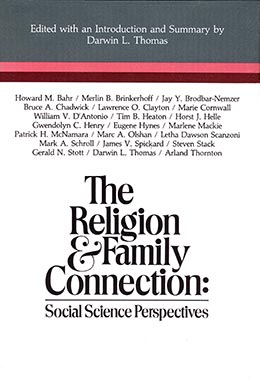Preface
Darwin L. Thomas
Preface, in The Religion and Family Connection: Social Science Perspectives, ed. Darwin L. Thomas (Provo, UT: Religious Studies Center, Brigham Young University, 1988), ix–x.
This volume had its beginning in March 1984 at the Conference on Religion and the Family sponsored by the Family and Demographic Research Institute at Brigham Young University. All of the nineteen chapters were prepared especially for this volume. Twelve were initially presented at the conference. Six presentations from the conference were chosen for publication in the Journal of Marriage and the Family May 1985, in a special section on religion and the family, and are reprinted in this volume.
The editor and the authors appreciate the encouragement given this project by Professor Stephen J. Bahr, Director of the Family and Demographic Research Institute, and the financial support received from that institute. They are grateful also for financial aid from two other sources: the College of Family, Home, and Social Sciences, under Dean Stan L. Albrecht, and the Department of Sociology, under its Chairman, James T. Duke. Without the continual encouragement of Professor Kent S. Brown of the Religious Studies Center at Brigham Young University, this volume would never have been completed. Last, and most important, Norene Petersen arranged the conference, contacted authors, typed and edited manuscripts, and in general made my editorial role manageable.
The authors of the various chapters were selected because of their interest and expertise in family and religious studies. They represent not only various perspectives in the social sciences (sociology, psychology, anthropology, and so on), but also various perspectives from a variety of Judaeo-Christian backgrounds (Jewish, Catholic, Mormon, Protestant, and so forth). The chapters are not official statements of any religious organization, but they are social scientists’ best efforts at describing the religion and family interface in various religious denominations.
Part I of the book introduces the discussion of the religion and family interface by placing the current heightened interest in the social sciences in historical context and identifying areas in which research and theory can make significant contributions. Part II develops the central message of the volume, namely, how to understand change and constancy in both religion and family in an ever-changing social order. Part III looks specifically at socialization processes and outcomes, emphasizing how religion and family combine to influence the child in the family. Part IV develops a broader perspective on the religion and family interface by presenting contrasting typologies and raising questions about how an investigator’s own presuppositions about religion and family might influence the questions asked and answers suggested. Part V uses research on the Mormon family to illustrate some potential contributions of future research and theory which take as their mandate the study of religion and family simultaneously.
If this volume adds to our current understanding of the religion and family connection by stimulating more and better comparative research and theory, then the editor and the authors will be more than amply rewarded for their work.
